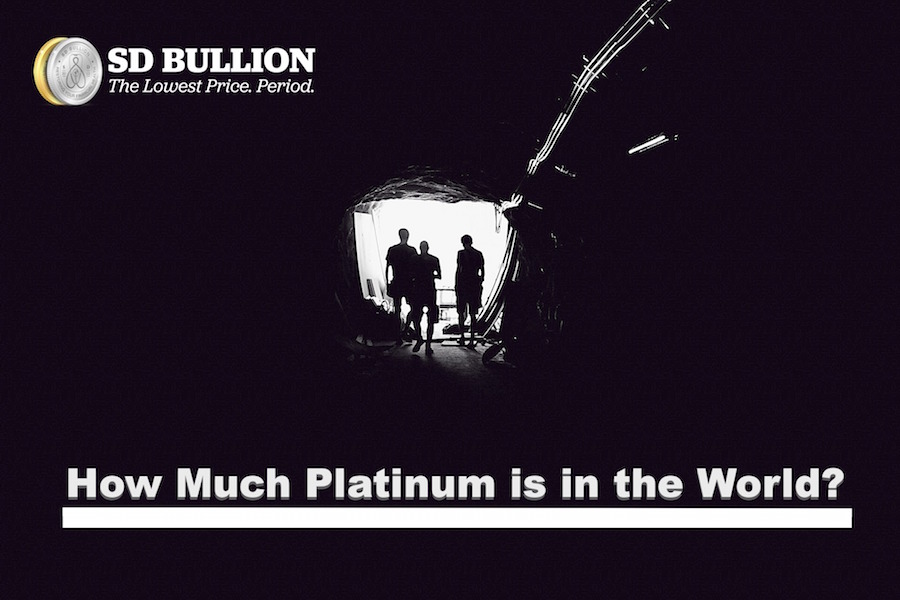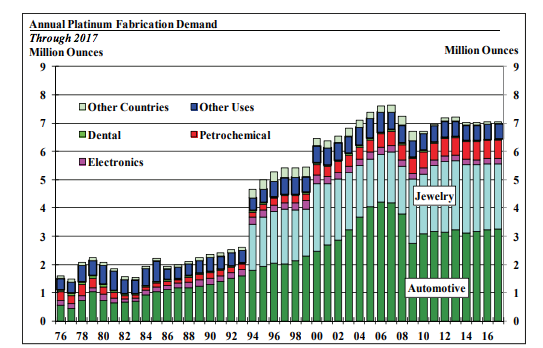Based on how little has been mined throughout history, platinum is the rarest physical precious metal we both buy and sell here at SD Bullion.
Here we cover platinum uses including how it is used by human begins, and in what percentage of annual platinum production is used by which platinum demand sectors.
Currently platinum is cheaper versus gold than it has been for over 110 years. Yet platinum supplies above ground are dwarfed by physical gold supplies. Come see why we still value platinum and believe it to be perhaps the best long term precious metal value today.
To learn even more about platinum investment fundamentals, be sure to check out our free 21st Century guide and platinum investing fundamental website section.
Due to platinum’s high melt value (3,215°F / 1,768°C), this rare white-colored precious metal is something of a relative newcomer to financial markets (compared to silver or gold).
For a very long time, platinum was actually discarded because it was too hard to work with.
Not all that long ago, 17th Century Spanish conquistadors could not even achieve fires burning hot enough to melt platinum from their gold and silver mined ores, much less isolate and identify platinum's true rarity and inherent value propositions now known and used today.
In fact, platinum derives its name from the Spanish term “platino”, which means "little silver".
Platinum was literally seen as a nuisance by Spanish new world gold and silver miners in Latin America.
Platinum is dense, hard and white, and it is actually mostly a byproduct of nickel and copper mining in South Africa (about 70% of new line platinum use supplies come from there).
Today, platinum is an invaluable metal used for any number of different purposes.
Here we will cover what is platinum used for in everyday life now.
Platinum Uses Today
The following yearly platinum demand graph gives us a breakdown of the major sectors of platinum uses globally.
Platinum uses come from 5 major sectors:
- Platinum Automotive Catalytic Converter Exhaust Pollution Prevention (heavy in diesel)
- Platinum Jewelry
- Platinum Petrochemical Uses
- Platinum Investment Demand (platinum bullion bars, coins, ETFs)
- Platinum Industrial Applications
Widely diverse applications also exist for platinum uses with over 25 industrial platinum uses such as:
- Platinum dental applications
- Platinum medical equipment
- Platinum in electronics and wiring (e.g. cell phones)
- Platinum chemical catalysts
- Platinum uses to create nitric acid fertilizers
- Platinum nitric acid explosives (partly why the USA deems it a militarily strategically critical element)
- Platinum turbine engine parts.
The uses of platinum group metals are in fact so critical to US National Security and US economic well being, that platinum is explicitly cited as being deemed 1 of 35 critical resources by the US Department of the Interior.
Platinum uses in Car Catalytic Converters
Platinum coated auto-catalysts will continue to help deter a large portion of the harmful emissions that a vehicle makes. Now over 95% of all new automobiles come with catalytic converters.
As the number of automobiles on the road worldwide increases continuously, air-pollution has become an environmental problem of public concern. Platinum along with palladium applications have been paramount in quelling greenhouse gas emissions.
A modern automobile’s catalytic converter helps convert over 90% of harmful elements like carbon monoxide, hydrocarbons, and nitrogen oxides from gasoline engines into less harmful carbon dioxide, nitrogen, and water vapor.
When platinum is fitted in diesel automobile engines, a catalytic converter converts over 90% of hydrocarbons, carbon monoxide, and cancer-causing particulate matters into carbon dioxide and water vapor.
Records show that over 93 tons or near 3 million troy ounces of physical platinum use went to make car catalytic converters in 2017 (about 43% of the platinum mined in the year).
Platinum use in Jewelry
Being both a highly ductile and malleable precious metal with a silvery sheen.
Platinum is also the least reactive precious metal and is known for its resistance to corrosion and tarnishing to open air. Moreover, platinum does not oxidize at any temperature.
Platinum is labeled as a 'noble metal' for it resists chemical action, does not corrode and is not easily attacked by acids. Even the thinnest sections of platinum are strong and sturdy.
Fine .999 platinum is slightly harder than pure .999 iron and does not wear out nor warp easily.
Hence uses for platinum jewelry typically retains its shape, and thus, provides perhaps the best and safest setting for diamonds.
We have platinum use in diamond earrings, finger rings, pendants, bracelets, and more. All are quite popular, especially in the eastern world.
About 35% of the platinum mined in 2017 was demanded by uses of platinum jewelry applications.
Platinum use in Petrochemicals
Platinum in a powdered form, it is often used as a catalyst in chemical reactions.
It is platinum electrodes that are often used for various processes in electrochemistry.
They are often coated with a layer of platinum black (Pt black or powdered platinum). This platinized platinum gives better results than pure .999 platinum does in applicable platinum-based chemical reactions.
Platinum use in Investment Demand
Platinum investing is a relatively new phenomenon given the platinum price discovery only recently began on the NYMEX in the 1970s.
Both platinum coins and platinum bars are actually more rare in the world than gold, and certainly silver. Yet platinum bullion coins, platinum bullion bars, and platinum ingots (old English reference to platinum bars) are traded or collected all over the world.
Of course, all in relatively small lots to other precious metal bullion products made with gold or silver as competing examples.
Uses of Platinum in Various Industrial Applications
It is estimated that about 1/5th of every manufactured product we use today, either contains platinum or requires platinum in some portion of its manufacturing.
Like gold, copper, silver, and other metals, platinum also has an acute limited supply which may be exhausted within a few decades. Based on the escalating demand for platinum and other critical commodities at these current price points.
Often mixed with cobalt, platinum is used to get strong permanent magnets.
Electrodes inside of glass are usually sealed with platinum because its thermal coefficient of expansion is almost equal to that of glass.
Platinum can be used in low voltage electrical contacts and electrical resistance wires.
Presently platinum is also used in resistance temperature detectors (RTDs), which are widely used to measure industrial temperatures.

Could the world's entire above ground physical Platinum Supply fit into your garage or living room?
More Uses of Platinum in Various Industrial Applications
Turbine engines for airplanes often use platinum applications.
Black platinum is often used in self-lighting gas lamps, ovens, and stove burners.
Platinum catalysts help manufacture nitric acid, the raw material for fertilizers and military explosives (thus partly why the US Department of the Interior deems platinum a National Security critical element).
The manufacturing of specialty silicones may require platinum for highly durable, waterproof, and electrically insulating materials. For instance, there is platinum use to create the removable coating for a paper of sticky labels or the release paper upon which many pre-baked goods are placed.
Manufacturing silicones for water repellent coatings, high consistency rubbers, and liquid silicone rubbers, often require platinum catalysts. These silicon applications can be found in cleaning products, airplane and automotive engine seals and gaskets, medical devices, high voltage cable covers, construction sealants, furniture polishes, as well in lipsticks, and even shampoos.
Platinum compounds like 'cisplatin', get used in chemotherapy medication to treat certain types of cancer. Platinum is often also present in various laboratory equipment, dental prostheses, various medical and surgical equipment as well.
In the manufacturing processes of silicone rubber and gel components, platinum agents help produce several types of medical implants (e.g. breast implants, joint replacement prosthetics, artificial lumbar discs, and vascular access ports).
The FDA has approved the use of platinum for it hasn't found any evidence suggesting toxicity.
Platinum-osmium alloys are used in implants such as pacemakers and replacement valves.
Computer hard disks often contain platinum in the magnetic layers. Hard disk drives are often now present in TVs, video games consoles, and other home entertainment systems. Use of platinum has helped reduce the disk size. Platinum applications have also led to improved data-storing capacity.
Platinum is present in the optical fibers and liquid crystal display glass, especially in laptops.
There are also trace amounts of platinum used in cell phone circuits.
Platinum used in the fuel cells could also help replace legacy battery applications to come.
Proton exchange membrane (PEM) fuel cells contain platinum catalysts and are now commonly used to power automobiles. Platinum fuel cells are also used to generate backup power for buildings.
Fuel cells that use platinum generate power quickly and silently with the help of oxygen and hydrogen while emitting only pure water (H20) as a by-product. Thus platinum fuel cells both deter air and noise pollution.
While platinum-based fuel cells have been commercialized, they are dwarfed in current market share to new technologies like hybrids and electric vehicles (EVs) that have hit the markets in recent years. And platinum-based fuel cells are of course not remotely close in competition to either diesel or gasoline automotive engines still today.
Platinum is also used in car spark plugs and in automotive airbag coatings. Platinum produced silicone can protect nylon airbags from an explosion as well these platinum-cured systems are long-lasting and stable, able to be folded up for years without erosion.
-
-
Although this was but a cursory dive into modern real-world uses for platinum and platinum-based manufacturing applications. As you can now see, platinum is a widely used and multivariate rare resource.
Platinum used for investments, adornment, pollution control, and within real-world goods critical to our modern ways of life will likely only escalate in the decades to come. Ironic given how little physical platinum is available on Earth.
Indeed platinum is one of the world’s most precious metals amongst a mere few others. Come learn how rare physical platinum is indeed.
Thank you for visiting us at SD Bullion.
***

















